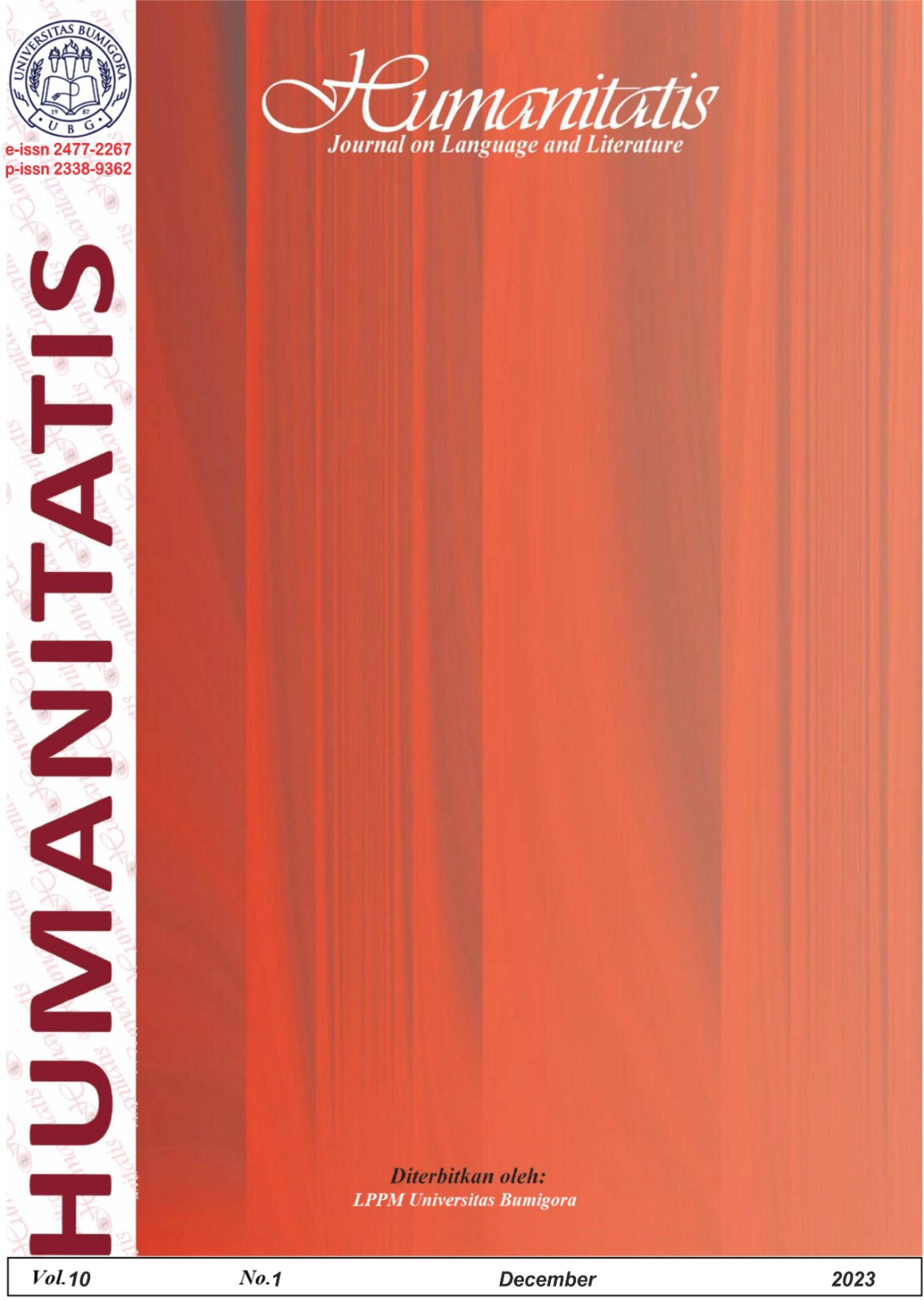The Correlation Study among EFL Learners’ Reticence, Motivation and Speaking Habit
DOI:
https://doi.org/10.30812/humanitatis.v10i1.3310Keywords:
Motivation, Speaking Habit, Students’ Speaking ReticenceAbstract
This research aims to investigate the correlation between students' reticence, motivation, and their speaking habits which effected their speaking skills. The method used is a quantitative approach with a correlational design. The population was the eleventh-grade students of MA NW Montong Kubur comprising one class with a total of 35 students. The researcher used the total sampling method, in which all eleventh-grade students became respondents. Data collection was done through questionnaire and speaking test. The results showed that the correlation coefficient between students' speaking anxiety and their speaking achievement was r=0.312. Although these two variables have a negative correlation, the value of r=0.312 can still be classified as a significant correlation. Furthermore, the correlation coefficient between students' motivation and their speaking habits was found to be r=0.032. This means that there is a positive relationship between these variables, but the value of r=0.032 indicates a low correlation. Finally, the results showed that the correlation coefficient between students' speaking reticence, motivation, and speaking habits was r=0.105 which means that these three variables have a positive correlation, although the value of 0.105 indicates a very low level of correlation.
References
Bakhtiarvand, M., & Adinevand, S. (2011). RETRACTED: is listening comprehension influenced by the cultural knowledge of the learners? A case study of Iranian EFL pre-intermediate learners. RELC Journal, 42(2), 111-124.
Brown, H.D. (2001). Teaching By Principles. An Interactive Approach To Language Pedagogy. Englewood Cliffs: Prentice Hall.
Brown, H.D. (2004). Language assessment: Principles and classroom practices. White Plains, NY: Pearson Education.
Brown, H.D. (2007) Principle Of Language Learning And Teaching: Fifth Editition. Addision Wesley Longman,Inc. A Pearson Education Company.
Brown, S., & Larson-Hall, J. (2012). Second language acquisition myths: Applying second language research to classroom teaching. University of Michigan Press ELT.
Chen, T. Y., & Chang, G. B. (2004). The relationship between foreign language anxiety and learning difficulties. Foreign language annals, 37(2), 279-289.
Chen, X., DeSouza, A. T., Chen, H., & Wang, L. (2006). Reticent behavior and experiences in peer interactions in Chinese and Canadian children. Developmental Psychology, 42(4), 656.
Creswell, John W. (2012). Educational Research-Planning, Conducting, And Evaluating Quantitative And Qualitative Research, 4th Edition, Boston: Pearson Education, Inc.,
Creswell, J. W., & Creswell, J. D. (2017). Research design: Qualitative, quantitative, and mixed methods approaches. Sage publications.
Donald, S. (2010). Learning how to speak: Reticence in the ESL classroom. ARECLS, 7, 41-58
Dörnyei, Z. (2001). Motivational Strategies In The Language Classroom. Cambridge: Cambridge University Press.
Dornyei, Z., & Kubanyiova, M. (2014). Motivating learners, motivating teachers: Building vision in the language classroom. Cambridge University Press (CUP).
Fen, F. S., Billy, A., Sanga, L., Shing, S. R., & Nadarajan, N. T. M. (2020). Causes of Undergraduate Students' Reticence in Malaysian ESL Classrooms. Selangor Humaniora Review, 4(1), 1-14.
Gardner (2004). The attitude/motivation test battery: international AMTB Research project the university of western Ontario, Canada
Ghonsooly, B., & Gholami, R. (2016). The relationship between reticence and personality types in Iranian university EFL classrooms. Journal of Language Teaching and Research, 7(2), 352-359.
Harmer, J. (2001). The Practice Of English Language Teaching. Third Edition. London: Longman.
Henry, A., Thorsen, C., & MacIntyre, P. D. (2021). Willingness to communicate in a multilingual context: part one, a time-serial study of developmental dynamics. Journal of Multilingual and Multicultural Development, 1-20.
Hofmann, S. G., Anu Asnaani, M. A., & Hinton, D. E. (2010). Cultural aspects in social anxiety and social anxiety disorder. Depression and anxiety, 27(12), 1117–1127
Listiawati, F. B., & Aryani, R. (2017, April). Speaking Habit as a Strategy to Improve the Students' Speaking Skill. In English Language and Literature International Conference (ELLiC) Proceedings (Vol. 1, pp. 107-109).
Locke, E. A., & Latham, G. P. (2019). The development of goal setting theory: a half century retrospective. Motivation Science, 5(2), 93.
MacIntyre, P. D., & Charos, C. (1996). Personality, attitudes, and affect as predictors of second language communication. Journal of language and social psychology, 15(1), 3-26.
Menggo, S. (2018). English learning motivation and speaking ability. Journal of Psychology and Instruction, 2(2), 70-76.
Mujis, D (2004). Doing Quantitative Research In Education With SPSS. London: Sage Publication
Nguyen, L. T., Hung, B. P., Duong, U. T. T., & Le, T. T. (2021). Teachers’ and Learners’ Beliefs About Pronunciation Instruction in Tertiary English as a Foreign Language Education. Frontiers in Psychology, 12, 739842.
Noels, K. A., Lascano, D. I. V., & Saumure, K. (2019). The development of self-determination across the language course: Trajectories of motivational change and the dynamic interplay of psychological needs, orientations, and engagement. Studies in Second Language Acquisition, 41(4), 821-851.
Numaya, M., & Higuchi, M. (1996). Japanese Reticence in Cross-Cultural Situations: Can It Be Communicative?. 新潟産æ¥å¤§å¦äººæ–‡å¦éƒ¨ç´€è¦, 4, 61-68.
Nunan, David. (2000). Language Teaching Methodology. Malaysia City: Pearson Education Ltd.
Nunan, D. (2003). The Impact of English as a Global Language on Educational Policies and Practices in the Asia-Pacific Region. TESOL Quarterly, 37, 589-613.
Nurhakiki (2018). The Correlation Study Among Students’ Speaking Anxiety, Motivation, and Speaking Performance Of Islamic Senior High School Al-Jauharen Jambi
Oztruk, G., & Gurbuz, N. (2012). The impact of gender on foreign language speaking anxiety and motivation. Procedia-Social and Behavioral Sciences, 70, 654-665.
Ryan, R. M., & Deci, E. L. (2022). Self-determination theory. In Encyclopedia of quality of life and well-being research (pp. 1-7). Cham: Springer International Publishing.
Schunk, Dale H., et al, Motivation in Education –Theory, Research, and Application-, 3rd Edition, New Jersey: Pearson Education, Inc. 2008.
Sugiyono, (2008). Metode Penelitian Kuantitatif Kualitatif Dan R&D. Bandung: Alfabeta.
Svenaeus, F. (2014). Diagnosing mental disorders and saving the normal: American Psychiatric Association, 2013. Diagnostic and statistical manual of mental disorders, American Psychiatric Publishing: Washington, DC. 991 pp., ISBN: 978-0890425558. Price: $122.70. Medicine, Health Care and Philosophy, 17, 241-244.
Talley, P. C., & Hui-Ling, T. (2014). Implicit and explicit teaching of English speaking in the EFL classroom. International Journal of Humanities and Social Science, 4(6), 38-45.
Tridinanti, G. (2018). The correlation between speaking anxiety, self-confidence, and speaking achievement of Undergraduate EFL students of private university in Palembang. International Journal of Education and Literacy Studies, 6(4), 35-39.
Wang, Y. (2022). Reticence in the EFL classroom: Voices from students in a Chinese university. Journal of Language Teaching and Research, 13(6), 1467-1476.
Wigfield, A., & Eccles, J. S. (2000). Expectancy–value theory of achievement motivation. Contemporary educational psychology, 25(1), 68-81.
Zare, M., Barjesteh, H., & Biria, R. (2021). The Effect of Critical Thinking-Oriented Dynamic Assessment on Iranian EFL Learners' Learning Potential: A Study of Reading Comprehension Skill. Teaching English as a Second Language Quarterly (Formerly Journal of Teaching Language Skills), 40(2), 193-227.
Zhang, H. (2018). Effects of different classroom activities on the English speaking proficiency of Chinese EFL students. International Journal of Scientific and Engineering Research, 8(8), 1-9.
















